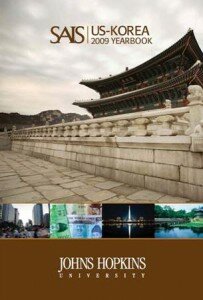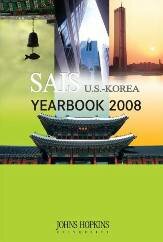Published on May 7, 2010
 The U.S.-Korea Institute at SAIS annouces the release of the fourth edition of the SAIS U.S. -Korea Yearbook.
The U.S.-Korea Institute at SAIS annouces the release of the fourth edition of the SAIS U.S. -Korea Yearbook.
Each fall semester at SAIS, the Korea Studies Program offers the course, “The Two Koreas: Contemporary Research and Record,” where students prepare an in-depth report on an issue of importance to Korean affairs in that year. As part of their research, students make a one-week research trip to Seoul to test their ideas with experts and officials. The SAIS U.S.-Korea Yearbook is a compilation of these student papers.
Student authors include: Tze Chin “Alvin” Wong, Paul Elliott, Sogaku Miyamoto, Ian Howard, Kee Hoon Chung, Jason Park, Momoko Sato, Neil K. Shenai, Nick Borst, Naoko Aoki, Zander Lanfried, and Sarah Yun.
Download the 2009 SAIS U.S.-Korea Yearbook.
Published on October 10, 2009
WPS 09-07: Economic Cooperation between South Korea and Kazakhstan, by Lee Jae-young (October 2009). As 97 percent of South Korean energy comes from imports, Central Asia is a very important area for developing and securing foreign energy resources. Among the countries in Central Asia, Kazakhstan has shown the highest tangible economic development results. Moreover, Kazakhstan, compared to other Central Asian countries, has the richest natural resources, a superior economy size, and a relatively stable political situation that could increase the speed of political modernization. Kazakhstan is also leading the region in terms of market reforms. In this paper, Dr. Lee examines the status of economic cooperation between South Korea and Kazakhstan and suggests basic policies to improve relations between the two countries.
Published on August 10, 2009
WPS 09-05: Myanmar-South Korean Economic Cooperation: Prospects and Strategies, by Chang-Yeon Kim (August 2009). Myanmar was the wealthiest country in Southeast Asia until the early 1960s but is now one of the poorest nations in the world. However, given its rich natural resource endowment as well as its key geostrategic position in Asia, Myanmar has the potential to rise to power once again. South Korean entrepreneurs have been investing in Myanmar’s resource extraction industries since 1990, and the South Korean government has been providing ODA to Myanmar since 1991. Although trade volume between Myanmar and South Korea is increasing, the full potential of Myanmar’s strategic value has yet to be acknowledged. In this paper, Mr. Kim analyzes the current status of Myanmar’s economy and its economic cooperation with South Korea, and discusses the potential benefits that could result from increased cooperation.
Published on February 10, 2009
WPS 09-02: Strategic Opportunities for South Korean Development of Energy Resources in Central Asia, by Yoon Sung-hak, Ph.D. (February 2009). In this paper, Dr. Yoon examines the status of trade relations and energy diplomacy between South Korea and Central Asia. His analysis provides an overview of the actual and potential energy resources and reserves in major Central Asian countries – Kazakhstan, Uzbekistan, Azerbaijan, and Turkmenistan – and identifies key opportunities for Korea to increase its soft power in Central Asia through cultural exchange and greater diplomatic and economic expansion.
Published on October 30, 2008
WPS 08-4: How Korea Could Become a Regional Power in Northeast Asia: Building a Northeast Asian Triad, by Im Hyug Baeg, Ph.D. (October 2008). In this paper, Dr. Im presents strategies for increasing South Korea’s soft power and smart power around Asia in order to close the power gap with its Northeast Asia neighbors, China and Japan.
Published on June 22, 2008
 The third edition of the SAIS U.S.-Korea Yearbook chronicles important developments in North and South Korea that characterized their relations with their allies and enemies in 2008. Each chapter was written by SAIS students in the course, “The Two Koreas: Contemporary Research and Record,” in the fall of 2008. Their insights were based not only on extensive reading and study, but also on numerous interviews conducted with government officials, scholars, NGO workers, academics and private sector experts in both Washington and Seoul.
The third edition of the SAIS U.S.-Korea Yearbook chronicles important developments in North and South Korea that characterized their relations with their allies and enemies in 2008. Each chapter was written by SAIS students in the course, “The Two Koreas: Contemporary Research and Record,” in the fall of 2008. Their insights were based not only on extensive reading and study, but also on numerous interviews conducted with government officials, scholars, NGO workers, academics and private sector experts in both Washington and Seoul.
The Yearbook is divided into two parts: South Korea’s Foreign Relations and North Korea’s Foreign Relations. In the first part, student authors explore the dynamic foreign policy changes that were brought about by the Lee Myung-bak administration, and how these policies affected South Korean politics both at home and abroad. In the second part, student authors explore how shifting power dynamics both in the United States, as well as among the member states of the Six-Party Talks, affected North Korea’s foreign relations in 2008. read more …
 The U.S.-Korea Institute at SAIS annouces the release of the fourth edition of the SAIS U.S. -Korea Yearbook.
The U.S.-Korea Institute at SAIS annouces the release of the fourth edition of the SAIS U.S. -Korea Yearbook.
 The third edition of the
The third edition of the 